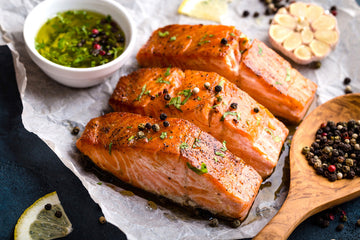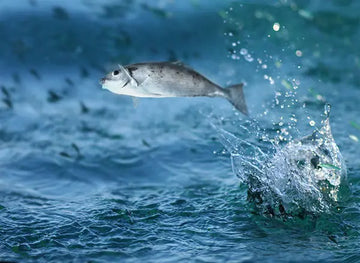Fish has long been heralded as one of the most nutritionally beneficial foods, abundant in high-quality proteins, essential fatty acids, vitamins, and minerals that fortify cardiovascular health, support neurological development, and promote overall vitality. However, mounting concerns regarding chemical contaminants in fish have led to a more critical evaluation of sourcing and consumption practices. Environmental pollutants, unsustainable aquaculture, and unethical preservation techniques have compounded these anxieties.
Are these concerns substantiated? Let’s examine the facts.
Mercury Contamination in Fish
Mercury, a potent neurotoxin, infiltrates aquatic ecosystems primarily through industrial emissions and fossil fuel combustion. Once in the water, it undergoes conversion to methylmercury—a highly toxic organic compound readily absorbed by aquatic organisms. Through a process known as bioaccumulation, this toxin concentrates in larger predatory fish such as shark and king mackerel.
Chronic exposure to methylmercury poses significant health risks, particularly for pregnant individuals and young children. It can impair fetal brain development, compromise memory, and damage the central nervous system. To mitigate risk, consumers are advised to choose low-mercury species such as Rohu, Roopchand, or ethically farmed prawns—especially those sourced from regulated, traceable supply chains.
Antibiotic Residues in Intensive Aquaculture
To prevent disease outbreaks in overcrowded aquaculture environments, antibiotics are frequently administered via medicated feed. While this may temporarily safeguard fish health, it results in residual pharmaceutical compounds within the fish tissue.
The cumulative consumption of such residues can diminish human responsiveness to antibiotics—a phenomenon known as antimicrobial resistance. This insidious public health crisis undermines the efficacy of critical medications, exacerbating the severity of infections and complicating treatment outcomes.
Pesticides and Industrial Toxins in Aquatic Environments
Runoff from agricultural land, domestic waste, and industrial discharge introduces harmful substances—such as pesticides and polychlorinated biphenyls (PCBs)—into freshwater and marine ecosystems. Fish inhabiting such contaminated waters inevitably absorb these toxins through their gills, skin, and muscle tissues.
Long-term ingestion of these substances has been linked to hepatic dysfunction, endocrine disruption, immunosuppression, and carcinogenesis. While the deleterious effects may not be immediate, their cumulative impact is undeniably hazardous.
Formalin: A Carcinogenic Preservative Disguised as Freshness
A particularly alarming malpractice involves the use of formalin—a solution of formaldehyde in water—to artificially preserve the appearance of freshness in fish. In regions where robust cold-chain infrastructure is lacking, certain vendors resort to this illegal and unethical measure, often applying formalin directly to fish or the ice used in transportation.
Formaldehyde is predominantly used for embalming biological specimens and in industrial applications—not for human consumption. Its ingestion can provoke mucosal irritation, organ toxicity, and has been definitively associated with various cancers. Disturbingly, formalin-treated fish are virtually indistinguishable from untreated fish by visual inspection alone.
Selecting Safer, Chemically Uncompromised Fish
The cornerstone of safe seafood consumption lies in informed decision-making. Fish cultivated in Biosafe aquaculture systems, where feed, water quality, and growth conditions are meticulously regulated, present a markedly lower risk of chemical contamination.
Equally important is the assurance of traceability—knowing the precise origin and handling process of your seafood. Fish harvested and transported under a continuous cold-chain regime (0–4°C) retain their nutritional value and remain free from the need for synthetic preservatives.
VTF’s Commitment to Ethical and Safe Fish Farming
VTF exemplifies a gold standard in safe, sustainable aquaculture. Cultivating 13 fish species—including Rohu, Roopchand, and freshwater prawns—VTF adheres to Biosafe farming protocols, replicating natural ecosystems while maintaining stringent quality control.
A meticulously maintained cold-chain infrastructure from harvest to doorstep ensures that the fish remain fresh, nutrient-rich, and unadulterated—without reliance on harmful chemical preservatives.
Why This Conversation Is Crucial
Food safety transcends mere culinary preference—it is a matter of public health. With fish constituting a dietary staple for many, contaminated seafood introduces long-term, systemic health risks. Informed consumers play a pivotal role in driving demand for transparency, accountability, and ethical practices within the seafood industry.
When consumers insist on knowing the provenance and handling of their food, they catalyze industry-wide reform.
Conclusion
The presence of harmful chemicals in fish is not a baseless fear—it is a substantiated concern. However, this does not warrant abstaining from seafood altogether. The solution lies in discernment: opt for fish such as Rohu, Roopchand, or prawns cultivated in Biosafe farms and distributed via traceable, cold-chain-integrated systems. Align with producers who uphold safety, integrity, and environmental responsibility.





